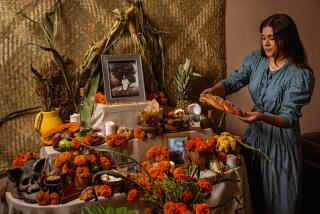A cross that Iztapalapans are glad to bear
MEXICO CITY — A short break in the annual Good Friday procession gave shepherds a chance to tape over the blisters forming under their calf-high sandals.
Eleven of the Apostles scratched at fake beards and adjusted their shoulder-length wigs as they waited for slowpoke Roman soldiers. Moms sprang from the sidewalks to fuss over the costumes of the Virgin Mary and Mary Magdalene.
A surly Roman sentry got the procession moving again. The trial of Jesus was starting, and more than a million spectators were expecting a crucifixion by 4 p.m.
For 164 years, the Iztapalapa neighborhood in the southeast of the capital has held a Holy Week extravaganza that ends with a reenactment of Jesus’ last hours. This year’s show had 1,270 actors and cost about $1 million.
Unlike the services in small churches and elaborate cathedrals across this mostly Catholic country, the Iztapalapa Passion of Christ is equal parts faith and fun. Many families that came for the pageant wandered away for the street food and carnival rides.
The day began with hundreds of men and boys dragging wooden crosses through neighborhood streets. They wore purple robes and crowns of thorns with yellow daisies and carnations. Some were barefoot. The crosses ranged from small ones pulled by children to elaborately carved giants nearly 20 feet long.
“It fulfills a religious promise,” said Francisco Javier Ortiz, a 28-year-old truck driver. He was covered in sweat and taking a breather. “It’s really hard.”
The swarms of cross-bearers looked like an unusual 10K race, as they rushed to stay ahead of the formal procession. Volunteers handed out water and orange slices. Tens of thousands of spectators stood on the sidewalks.
“It wipes all your sins clean,” said Arturo Gonzalez, 15.
“No, it doesn’t,” said his cousin Jovanny Perez Gonzalez, 13. “You just do it because it helps your faith.”
It was the first year the boys had dragged their wooden crosses for Good Friday. “I did it barefoot,” said Arturo. “I got it wrapped up and now it feels OK.”
They were outside the medical tent on Cerro de la Estrella, or Star Hill. The cross-bearers who completed the two-mile course ended up on the hillside’s vast lawn.
As the day progressed, the giant crosses piled up and participants napped in the shade or sucked on ice pops and talked about their aches and pains.
“We wash their feet and put on a balm for blisters and then wrap them,” said Dr. Miriam Peralta, one of the physicians attending to the injured. “I think we’ve done 27 in the last hour.”
At the top of Cerro de la Estrella were three wooden crosses, the largest more than three stories tall. Chain-link fencing separated the crowds from the site. The crosses had ladders and rope pulleys that would be used to secure Jesus and the two thieves who would be hung on either side.
Down the hill, about a mile away, the procession of Apostles, Roman legions and hundreds of children dressed in purple and pastel robes had finally reached the scene of Jesus’ trial. The main stage climbed to four stories. It had a Romanesque look of faux columns and gold paint that took a page from Caesars Palace, Las Vegas.
Tens of thousands of people jammed the city park and plaza in front of the stages. Two giant-screen TVs projected a view to those farther back, and actors had microphones that delivered their lines through a giant public address system.
Men playing the Jesus-hating Scribes and Pharisees railed against the ostensible son of God, saying he was in fact planning a revolt against the Roman Empire. Jesus was dragged into court, hands bound, and mocked.
Emmanuel Guillen Roldan, a 22-year-old accounting major, was picked to portray Jesus this year. Like nearly all the actors, he’s from the neighborhood and has grown up with the pageant.
“I remember telling my dad, ‘When I grow up, I want to be the Christ,’ ” Guillen said in an interview this week. “He really encouraged me to try out.”
The minimum requirements for the role mirror what most people here believe about Jesus: no tattoos, no vices, no wife and no children.
Guillen also had to undergo rigorous physical training to drag his cross from the court to his Crucifixion.
His routine, which he said began in January, included running with a log on Tuesdays and Thursdays, and dragging a 110-pound cross on Wednesdays and Fridays.
“This has been my dream,” he said.
His court scene lasted more than an hour. A belly dancer piqued crowd interest with a non-Scriptural musical interlude, perhaps to underscore the decadence of the ruling Romans. Then after a series of failed appeals, Pontius Pilate finally washed his hands of the matter and let the death sentence stand.
Guillen then began the long climb from the city hall plaza to the top of the hill that faced north over the capital.
He followed Roman soldiers on horseback past crowds snapping pictures. One legionnaire whipped him repeatedly as he climbed.
A repentant Judas tossed gold-colored plastic coins to the crowd. “I don’t want them, they burn my hands,” said Jesus’ traitor.
The crying of Jesus’ mother, Mary, boomed over the public address system.
Then a sentry called for the hammer and nails, and the two thieves were hoisted up onto their crosses, followed by Guillen. The sound system blared the sound of hammering.
“Forgive them, Father,” said a gasping Guillen from his perch on the cross, “for they know not what they do.”
Carlos Martinez in The Times’ Mexico City Bureau contributed to this report.
More to Read
Sign up for Essential California
The most important California stories and recommendations in your inbox every morning.
You may occasionally receive promotional content from the Los Angeles Times.










